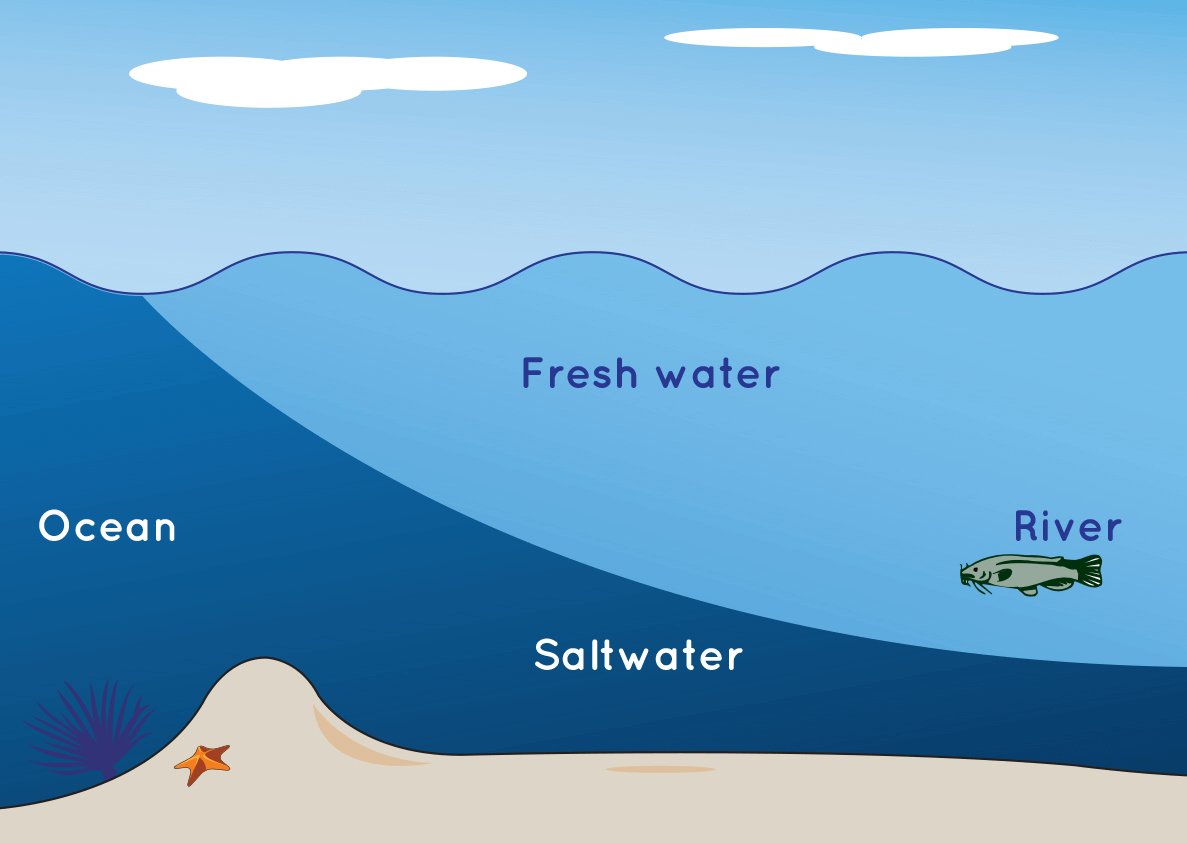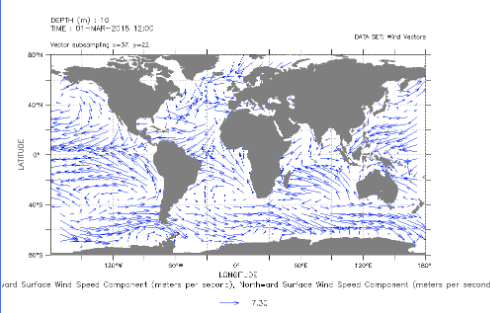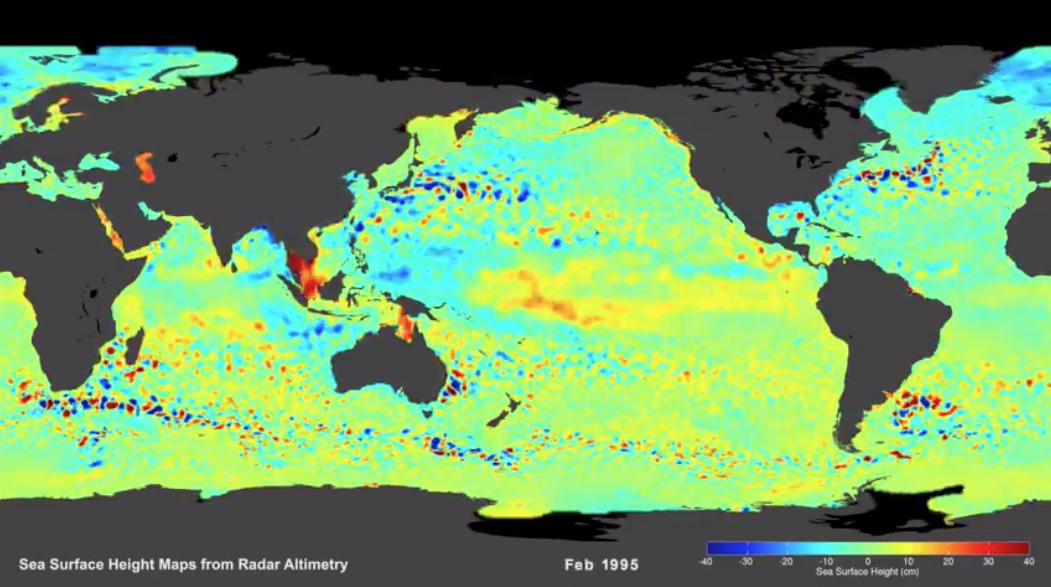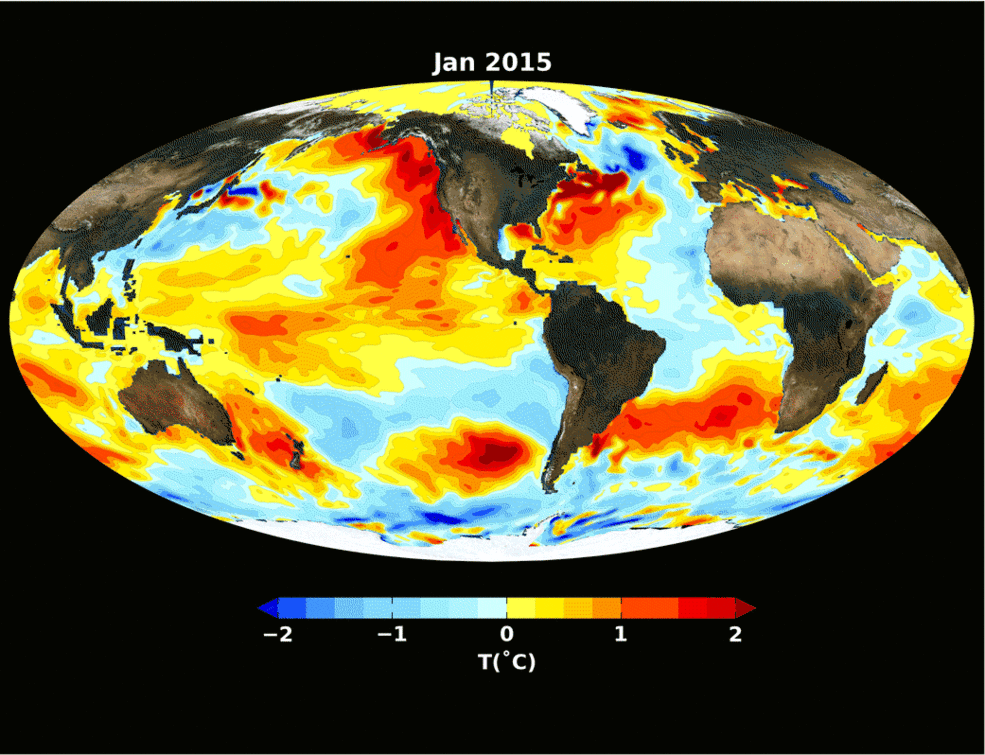Ocean Circulation Patterns

Ocean waters are constantly on the move; understanding how and why they move is not an easy task. However, it is an important job considering that these waters affect Earth’s climate, as well as habitats for plants and animals, even on land.
Why do ocean waters move?
Density differences are the key to why ocean waters move. The oceans are mostly composed of less dense water near the surface over more dense water in the ocean depths. These two regions don't mix except in certain special areas.
The saltiness of water is one factor that affects its density. In general, ocean water is more dense than fresh water, since ocean water contains more salt. That is why it is easier to float in the ocean than in a fresh-water swimming pool or lake, and fresh water floats on top of salty ocean water.
Temperature is another factor that affects density. Heat makes water lighter, or less dense. Both salinity and temperature work affect the density of water at the same time, so things can get complicated. For example, warm salt water might float on colder, less salty water.
Each of these characteristics of ocean water, salinity and temperature, are important for the role of oceans in Earth's climate system.

Temperature
Like the heated air in a hot-air balloon, heated water expands. Heat makes water lighter, so it rises. Solar heat absorbed at the equator causes water to expand. In this way, heated water raises the normal level of the sea surface. The heat in the water is carried to higher latitudes by ocean currents where it is released into the atmosphere. Water chilled by colder temperatures at high latitudes contracts (thus gets denser), sinks, and moves back toward the equator.
The ocean does an excellent job of absorbing excess heat from the atmosphere. One big part of the ocean’s role is to soak up energy (heat) and distribute it more evenly around the Earth. The top few meters of the ocean store as much heat as Earth's entire atmosphere. So, as the planet warms, it's the ocean that gets most of the extra energy. Warmer water masses are found near equatorial regions and colder water masses are found near polar regions.
Sites on islands or coasts benefit from the moderating effect of the ocean and have "maritime" climates (like San Francisco). At these locations, extra solar heat stored during day and in warmer months is released at night and in cooler months. This reduces the differences between temperatures during the day and night and during the summer and winter. Sites away from the coast lack this temperature buffering and have extreme "continental" climates (like Wichita). At these locations, there is a large difference between temperatures during the day and night, and during the warmest and coldest parts of the year.
Salinity
Salt is really just a molecule in the ocean water, but collectively, that salinity plays an important role in the ocean circulation. The rule is simple - salt makes water heavier, so it sinks. In other words, salty water has more materials in the water than freshwater which makes it more dense than freshwater. LIke temperature, the salt in the ocean affects its density (the amount mass per volume). Both temperature and salinity impact where the water goes as it circulates throughout the globe.

Not all oceans have the same salinity. In fact, the North Atlantic Ocean tends to be the saltiest, much more than the Pacific. Differences in temperature and salt content of the water cause some areas of water to sink and some areas of water to rise. And so we tend to see the sinking water at the poles, the water rising back up at the equator, and if you connect the two together, what you have is an overturning that is deep in the ocean. It's like a big conveyor belt that operates in the ocean.
Salinity changes can create ocean circulation changes that, in turn, may impact regional and global climates. Differences in salinity also affect sea life.
Where does ocean water go?
All this heating and cooling and melting and thawing creates a layered ocean: warmer fresher water on top, cold salty water at the bottom. Organisms move from one layer to another, and plant and animal remains containing nutrients "rain" down, but the layers stay fairly separate in all but a few places.
Ocean currents are simply masses of water in motion and these circulate the water and all that’s in it. Driven by wind and other forces, currents on the ocean surface cover our planet. Some span hundreds to thousands of miles across vast ocean basins in well-defined flows. Others are confined to particular regions and form slow-moving, circular pools. Seen from space, the circulating waters offer a study in both chaos and order.
Currents can be broken down into two forms of circulation. One is wind-driven circulation and the other is thermohaline circulation. The image below shows the characteristic surface currents of the ocean.

Surface Currents
At the ocean surface, currents are primarily driven by winds. These winds help the atmosphere and ocean to move heat around the world. The winds drive an ocean circulation transporting warm water to the poles along the sea surface.
Warm Vs. Cold Surface Currents
-
Warm surface currents invariably flow from the tropics to the higher latitudes, driven mainly by atmospheric winds, as well as the earth's rotation.
-
Cold surface currents come from polar and temperate latitudes, and they tend to flow towards the equator. Like the warm surface currents, they are driven mainly by the wind.
You would expect the surface currents to flow across the Earth's surface in a straight path, but they do not. Instead, they currents are deflected because of the Coriolis force, which is due to the Earth's rotation. This deflection helps form circulation systems known as gyres. Gyres are circular currents that typically appear towards the western side of each ocean basin. Water flows in a circular pattern--clockwise in the Northern Hemisphere, and counterclockwise in the Southern Hemisphere.
Deep Ocean Currents (Thermohaline Currents)
Deep below the surface, there are currents that are controlled by water density, which depends on the temperature and salinity of the water. Colder, saline water masses are more dense and sink; while warmer, fresher water masses are less dense and rise. Less saline water is found where there is more precipitation or river input. More saline water masses are found in areas where there is a lot of evaporation because salt is left in the water, or in polar areas because as ice forms, salt is left in the water. This cold, saline water sinks because of its greater density.
Eventually, the cold, dense water “upwells” to the surface bringing many nutrients from the depths up to the surface waters where marine life thrive; this is indicated by productive fishing grounds. This is triggered when winds blow water across the ocean’s surface, allowing deeper water to rise up to replace this displaced surface water. This process is known as “upwelling.” It occurs along the coasts, as well as in the open ocean.

A global "conveyor belt" set in motion when deep water sinks and circulates around Earth’s ocean basins. The water in the North Atlantic sinks because it is cold and salty. Being both cold AND salty makes it really dense, so it can sink very far. In fact, it is the densest ocean water on Earth! It then flows southward deep along the ocean floor of the Atlantic Ocean through the Indian Ocean, eventually mixing with the surface currents in the Pacific Ocean. The surface current flows back throughout the Indian Ocean into the Atlantic Ocean, returning surface water to the North Atlantic Ocean and driving the Gulf Stream The Gulf Stream flows along the east coast of the United States and across the northern region of the Atlantic
Ocean, causing Great Britain and Europe to have fairly moderate temperatures. It can take a thousand years for water from the North Atlantic to find its way into the North Pacific.
Deep Circulation
The thermohaline ocean currents have a strong effect on the Earth System. This “conveyer belt” type circulation moves heat around the Earth through all of the ocean basis; the interconnected process of “overturning circulation” helps to regulate Earth’s climate.
Why do I care about how the ocean moves?
Ocean waters are constantly on the move. Ocean circulation plays a key role in distributing solar energy and maintaining climate by moving heat from Earth’s equator to the poles. How they move influences climate and living conditions for plants and animals, even on land. They also affect the routes taken by ships as they carry goods and people across the sea.
Scientists do not completely understand the thermohaline flow of water, but they are monitoring the melting sea and land ice into the North Atlantic Ocean; an influx of freshwater causes a disruption to the deep ocean circulation. This freshwater is less dense and would not sink, causing the global flow of ocean water to slow, drastically changing Earth’s climate. Scientists think that if the conveyor slows or stops, the warmer surface water would not be propelled back toward the north Atlantic through the Gulf Stream. This could cause Europe to have a colder climate.
Sources:
Disciplinary Core Ideas:
Crosscutting Concepts:
- Patterns
- Cause and Effect
- Stability and Change









